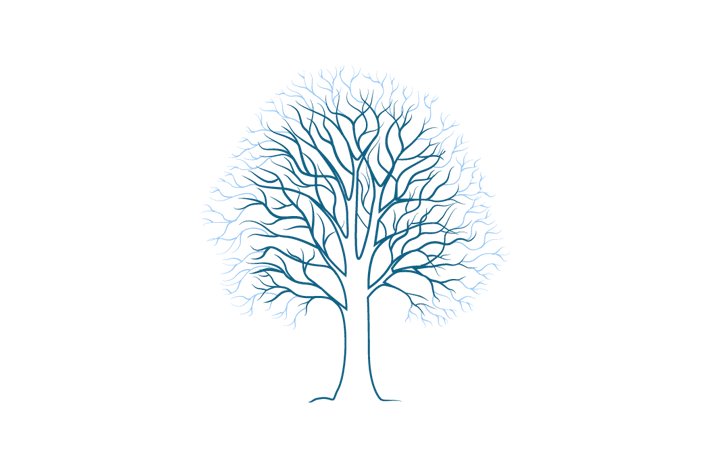Pruning Services
The Blue Tree Company offer a wide range of tree pruning services to suit all shapes and sizes of tree. We’ll work with you to ensure that the service chosen will achieve your desired outcome
It’s always worth addressing the pruning of a tree from the early stages of development. Problems that are relatively easy to address as the tree is forming, may be more difficult to manage later. Potentially weak unions must be managed to retain the safety and condition of the tree, and reduce potential hazards. Maintaining a healthy and safe tree is particularly important when it is in close proximity to people and property. Sensible management can help to address or mitigate potential hazards
Formative Pruning
Formative pruning is generally completed when a tree is very young (generally up to 5-10 years). It encourages the tree to grow into an attractive and healthy structural form. Ideally, this pruning should be started when the tree is in the nursery in order to influence the structure, shape or size of a tree’s crown
Formative pruning is used to remove any future weaknesses in the tree and to give a desired shape. Potential weaknesses are caused by crossing branches, or any part of the tree that has grown in an unusual way.
Crown Reduction
Crown reduction is undertaken to reduce the height and/or spread of a tree. The aim of crown reduction is to reduce mechanical stress on a tree, to make the tree more suited to its immediate environment, or to increase light to a site. The final result will retain a large proportion of the tree’s main framework, as well as its leaf bearing structure
It’s important not to reduce a crown too much – this can have dangerous implications for the tree. This is particularly relevant if the tree is a more mature tree, as removing large limbs can leave large wounds on the tree, which may become susceptible to pest and disease
Crown Lifting
Crown lifting lifts the lowest part of the canopy to a desired height. The lowest branches are removed creating more space under the tree’s canopy. Some examples of where this tree surgery service can be effective are: when a tree is growing over a pavement, a lawn, street, vehicle access or over a bus stop
If a tree is not regularly pruned back, this can lead to damage to property. It can also restrict access routes or fire escapes for commercial properties
Crown Thinning
Crown thinning is the removal of carefully selected live branches from throughout the tree’s canopy. This allows more light to come through the canopy. The aim of crown thinning is to achieve an even density of foliage throughout the crown around a balanced and attractive structure to the tree. This can make trees less vulnerable to the potential damaging effects of strong winds
Tree Thinning
Tree thinning is an effective tool in woodland management. It involves removing some trees, or the growth on some trees, to make space. This might need to be done simply for the benefit of the trees, or it may be to clear a required access route or space. This technique can also be used to create ‘rides’ or ‘glades’ to encourage more biodiversity, both in flora and fauna
This practice is most helpful in managing areas with a dense covering of trees. For example a forest or a woodland, and also in timber production. With tree thinning, the smaller, weaker trees are removed allowing space for the stronger trees to grow. Some ‘even aged’ woodlands can also benefit from encouraging younger areas of woodland to come through
Pollarding
Pollarding is the practice of a cycle of pruning that maintains a small, compact canopy. Ideally pollarding is first done to a tree when it is young. It then needs to be repeated at regular intervals to maintain the shape and health of the tree. Although we don’t recommend it, pollarding can also be completed on an older tree by completing an aggressive cut to bring the tree back to pollard points
Once a tree has been pollarded, this practice needs to be maintained for the rest of the tree’s natural life. This is because pollard points can become weak over time. The frequency at which this needs to be done is normally every 3-5 years, depending on the species of the tree
Coppicing
Coppicing is the practice of reducing a tree all the way down to a ‘stool’, with the intention of encouraging regrowth in multiple stems. This practice of tree management is only applicable to certain species of tree. Coppicing is an ancient woodland management technique that is also popular for commercial ventures. For example, Hazel is often coppiced for the production of walking sticks. The production of charcoal also relies on this technique in the wood’s development
Coppicing must be maintained on a cyclical basis, to produce consistent size regrowth and to avoid old stools falling apart under their own weight. There are also particular seasons when a tree should be coppiced if the health and condition of the tree is to be maintained
Our Process
On our initial site visit, we will inspect the site and go through the possible options. Based on the customer’s desired end result, we will propose a strategy that works well for you and your trees. We try to find the most natural form for the tree and advise our customers accordingly
On the initial site visit, we not only record what needs to be done, but also note the tools required and complete a pre-risk assessment. Once we have visited your site, we take notes of the work that is agreed, that will be passed electronically to our team. Our team will book in a date for the work that best suits you and will liaise with you on the day, to ensure that everything is completed to your satisfaction. On the day of work, the team will start by updating the risk assessment with specific conditions on the day of work, to ensure that every activity if carefully managed


